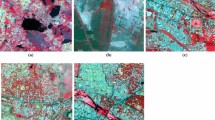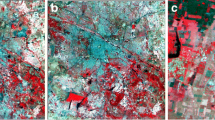Abstract
This paper develops a new crop mapping method through combined utilization of both time and frequency information based on wavelet variance and Jeffries–Matusita (JM) distance (CIWJ for short). A two-dimensional wavelet spectrum was obtained from datasets of daily continuous vegetation indices through a continuous wavelet transform using the Mexican hat and the Morlet mother wavelets. The time-average wavelet variance (TAWV) and the scale-average wavelet variance (SAWV) were then calculated based on the wavelet spectrum of the Mexican hat and the Morlet wavelet, respectively. The class separability based on the JM distance was evaluated to discriminate the proper period or scale range applied. Finally, a procedure for criteria quantification was developed using the TAWV and SAWV as the major metrics, and the similarity between unclassified pixels and established land use/cover types was calculated. The proposed CIWJ method was applied to the middle Hexi Corridor in northwest China using 250-m 8-day composite moderate-resolution imaging spectroradiometer (MODIS) enhanced vegetation index (EVI) time series datasets in 2012. The CIWJ method was shown to be efficient in crop field mapping, with an overall accuracy of 83.6 % and kappa coefficient of 0.7009, assessed with 30 m Chinese Environmental Disaster Reduction Satellite (HJ-1)-derived data. Compared with methods utilizing information on either frequency or time, the CIWJ method demonstrates tremendous potential for efficient crop mapping and for further applications. This method could be applied to either coarse or high spatial resolution images for agricultural crop identification, as well as other more general or specific land use classifications.






Similar content being viewed by others
References
Arvor, D., Jonathan, M., Meirelles, M. S. P., Dubreuil, V., & Durieux, L. (2011). Classification of MODIS EVI time series for crop mapping in the state of Mato Grosso, Brazil. International Journal of Remote Sensing, 32(22), 7847–7871. doi:10.1080/01431161.2010.531783.
Bashmachnikov, I., Belonenko, T. V., & Koldunov, A. V. (2013). Intra-annual and interannual non-stationary cycles of chlorophyll concentration in the Northeast Atlantic. Remote Sensing of Environment, 137, 55–68.
Biggs, T. W., Thenkabail, P. S., Gumma, M. K., Scott, C. A., Parthasaradhi, G. R., & Turral, H. N. (2006). Irrigated area mapping in heterogeneous landscapes with MODIS time series, ground truth and census data, Krishna Basin, India. International Journal of Remote Sensing, 27(19), 4245–4266. doi:10.1080/01431160600851801.
Biradar, C. M., & Xiao, X. (2011). Quantifying the area and spatial distribution of double- and triple-cropping croplands in India with multi-temporal MODIS imagery in 2005. International Journal of Remote Sensing, 32(2), 367–386. doi:10.1080/01431160903464179.
Biswas, A., & Si, B. (2011). Application of continuous wavelet transform in examining soil spatial variation: a review. Mathematical Geosciences, 43(3), 379–396. doi:10.1007/s11004-011-9318-9.
Bridhikitti, A., & Overcamp, T. J. (2012). Estimation of Southeast Asian rice paddy areas with different ecosystems from moderate-resolution satellite imagery. Agriculture, Ecosystems & Environment, 146(1), 113–120.
Daubechies, I. (1990). The wavelet transform, time-frequency localization and signal analysis. IEEE Transactions on Information Theory, 36(5), 961–1005.
Galford, G. L., Mustard, J. F., Melillo, J., Gendrin, A., Cerri, C. C., & Cerri, C. E. P. (2008). Wavelet analysis of MODIS time series to detect expansion and intensification of row-crop agriculture in Brazil. Remote Sensing of Environment, 112(2), 576–587.
Gaucherel, C. (2002). Use of wavelet transform for temporal characterisation of remote watersheds. Journal of Hydrology, 269(3), 101–121.
Geerken, R. A. (2009). An algorithm to classify and monitor seasonal variations in vegetation phenologies and their inter-annual change. ISPRS Journal of Photogrammetry and Remote Sensing, 64(4), 422–431.
He, Y., Guo, X., & Cheng Si, B. (2007). Detecting grassland spatial variation by a wavelet approach. International Journal of Remote Sensing, 28(7), 1527–1545. doi:10.1080/01431160600794621.
Howard, D. M., Wylie, B. K., & Tieszen, L. L. (2012). Crop classification modelling using remote sensing and environmental data in the Greater Platte River Basin, USA. International Journal of Remote Sensing, 33(19), 6094–6108. doi:10.1080/01431161.2012.680617.
Jain, M., Mondal, P., DeFries, R. S., Small, C., & Galford, G. L. (2013). Mapping cropping intensity of smallholder farms: a comparison of methods using multiple sensors. Remote Sensing of Environment, 134, 210–223. doi:10.1016/j.rse.2013.02.029.
Johnson, D. M. (2013). A 2010 map estimate of annually tilled cropland within the conterminous United States. Agricultural Systems, 114, 95–105.
Justice, C. O., Vermote, E., Townshend, J. R. G., Defries, R., Roy, D. P., Hall, D. K., et al. (1998). The Moderate Resolution Imaging Spectroradiometer (MODIS): land remote sensing for global change research. Geoscience and Remote Sensing, IEEE Transactions on, 36(4), 1228–1249.
Li, Z., & Fox, J. M. (2012). Mapping rubber tree growth in mainland Southeast Asia using time-series MODIS 250 m NDVI and statistical data. Applied Geography, 32(2), 420–432.
Mi, X., Ren, H., Ouyang, Z., Wei, W., & Ma, K. (2005). The use of the Mexican Hat and the Morlet wavelets for detection of ecological patterns. Plant Ecology, 179(1), 1–19. doi:10.1007/s11258-004-5089-4.
Nuarsa, I. W., Nishio, F., Hongo, C., & Mahardika, I. G. (2012). Using variance analysis of multitemporal MODIS images for rice field mapping in Bali Province, Indonesia. International Journal of Remote Sensing, 33(17), 5402–5417. doi:10.1080/01431161.2012.661091.
Pagano, T. S., & Durham, R. M. (1993). Moderate resolution imaging spectroradiometer (MODIS). In (Vol. 1939, pp. 2).
Partal, T. (2012). Wavelet analysis and multi-scale characteristics of the runoff and precipitation series of the Aegean region (Turkey). International Journal of Climatology, 32(1), 108–120. doi:10.1002/joc.2245.
Qiu, B. W., Zeng, C. Y., Tang, Z. H., & Chen, C. C. (2013a). Characterizing spatiotemporal non-stationarity in vegetation dynamics in China using MODIS EVI dataset. Journal of Environmental Monitoring and Assessment, 185(11), 9019–9035. doi:10.1007/s10661-013-3231-2.
Qiu, B. W., Zeng, C. Y., Tang, Z. H., Li, W. J., & Hirsh, A. (2013b). Identifying scale-location specific control on vegetation distribution in mountain-hill region. Journal of Mountain Science, 10(4), 541–552.
Qiu, B. W., Zhong, M., Tang, Z. H., & Wang, C. Y. (2014). A new methodology to map double-cropping croplands based on continuous wavelet transform. International Journal of Applied Earth Observation and Geoinformation, 26, 97–104. doi:10.1016/j.jag.2013.05.016.
Sakamoto, T., Yokozawa, M., Toritani, H., Shibayama, M., Ishitsuka, N., & Ohno, H. (2005). A crop phenology detection method using time-series MODIS data. Remote Sensing of Environment, 96(3), 366–374.
Sakamoto, T., Van Nguyen, N., Ohno, H., Ishitsuka, N., & Yokozawa, M. (2006). Spatio-temporal distribution of rice phenology and cropping systems in the Mekong Delta with special reference to the seasonal water flow of the Mekong and Bassac rivers. Remote Sensing of Environment, 100(1), 1–16.
Sakamoto, T., Gitelson, A. A., & Arkebauer, T. J. (2013). MODIS-based corn grain yield estimation model incorporating crop phenology information. Remote Sensing of Environment, 131, 215–231.
Singh, A., Dutta, R., Stein, A., & Bhagat, R. M. (2012). A wavelet-based approach for monitoring plantation crops (tea: Camellia sinensis) in North East India. International Journal of Remote Sensing, 33(16), 4982–5008.
Sun, H., Xu, A., Lin, H., Zhang, L., & Mei, Y. (2012). Winter wheat mapping using temporal signatures of MODIS vegetation index data. International Journal of Remote Sensing, 33(16), 5026–5042. doi:10.1080/01431161.2012.657366.
Torrence, C., & Compo, G. P. (1998). A practical guide to wavelet analysis. Bulletin of the American Meteorological Society, 79(1), 61–78. doi:10.1175/1520-0477(1998)079<0061:apgtwa>2.0.co;2.
Van Niel, T. G., McVicar, T. R., & Datt, B. (2005). On the relationship between training sample size and data dimensionality: Monte Carlo analysis of broadband multi-temporal classification. Remote Sensing of Environment, 98(4), 468–480.
Wardlow, B. D., Egbert, S. L., & Kastens, J. H. (2007). Analysis of time-series MODIS 250 m vegetation index data for crop classification in the US Central Great Plains. Remote Sensing of Environment, 108(3), 290–310.
Xiao, X., Boles, S., Frolking, S., Salas, W., Moore Iii, B., Li, C., et al. (2002). Observation of flooding and rice transplanting of paddy rice fields at the site to landscape scales in China using VEGETATION sensor data. International Journal of Remote Sensing, 23(15), 3009–3022.
Zhang, M.-Q., Guo, H.-Q., Xie, X., Zhang, T.-T., Ouyang, Z.-T., & Zhao, B. (2013). Identification of land-cover characteristics using MODIS time series data: an application in the Yangtze River Estuary. PloS One, 8(7), e70079.
Zhou, Y., Chen, J., Chen, X.-h., Cao, X., & Zhu, X.-l. (2013). Two important indicators with potential to identify Caragana microphylla in xilin gol grassland from temporal MODIS data. Ecological Indicators, 34, 520–527.
Acknowledgments
This work was supported by the National Natural Science Foundation of China (NSFC) (grant no. 41071267), Scientific Research Foundation for Returned Scholars, Ministry of Education of China ([2012]940), and the Science & Technology Department of Fujian Province, China (grant no. 2012I0005, 2012J01167).
Author information
Authors and Affiliations
Corresponding author
Rights and permissions
About this article
Cite this article
Qiu, B., Fan, Z., Zhong, M. et al. A new approach for crop identification with wavelet variance and JM distance. Environ Monit Assess 186, 7929–7940 (2014). https://doi.org/10.1007/s10661-014-3977-1
Received:
Accepted:
Published:
Issue Date:
DOI: https://doi.org/10.1007/s10661-014-3977-1




